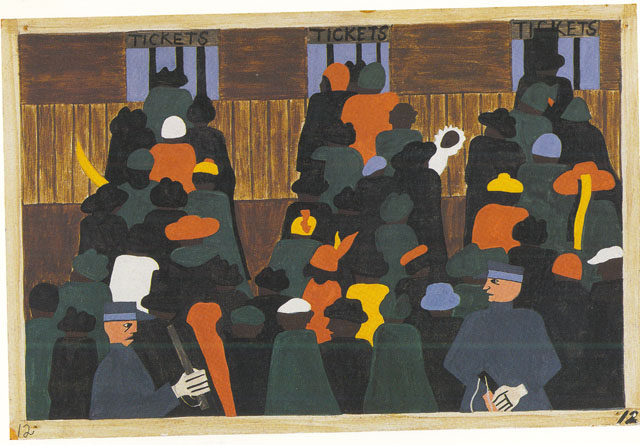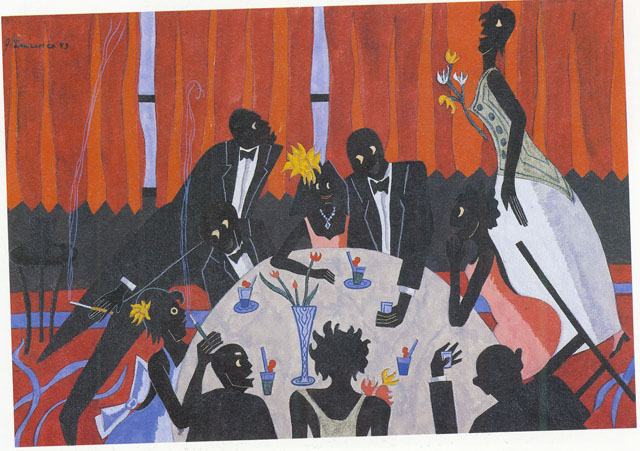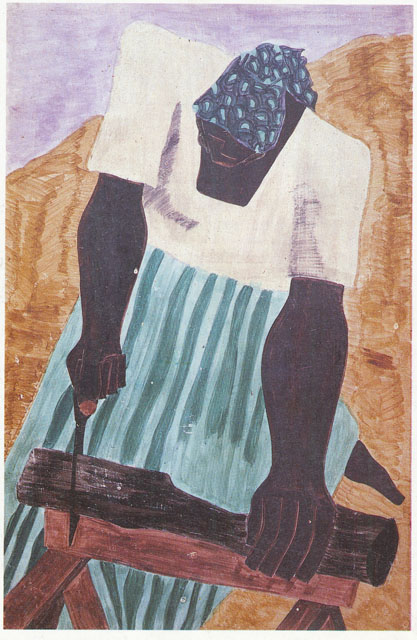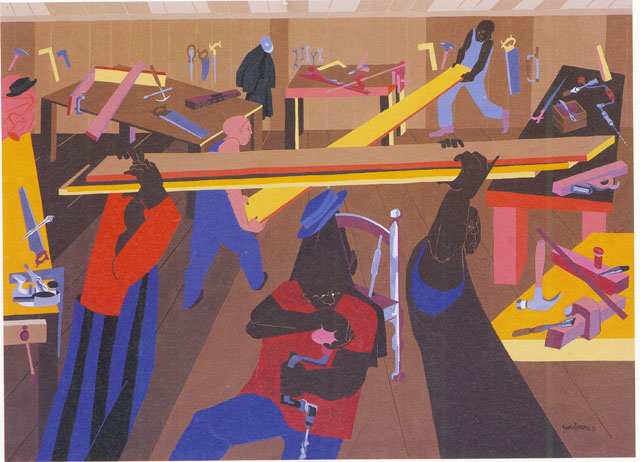
Casey Kirpes
History
in Painting: Jacob Lawrence
“If at times my productions do not express the conventionally beautiful, there is always an effort to express the universal beauty of man’s continuous struggle to lift his social position and to add dimension to his spiritual being.” (Wheat, 47).
African Americans had many hardships to deal with during the American Revolution. When people came to America to build their lives, the Europeans brought Africans here by force to create a better economy for themselves. Through the progression of the American economy the minorities started to feel that they needed to be treated like equals in the “land of the free.” Jacob Lawrence was of African descent and he too believed in equal civil rights for all. He became interested in art and delivered his messages through paintings that he created throughout the twentieth century. Lawrence was a painter, drawing and mural artist. He created his works throughout a time in America when it was hard for the black man to come up ahead. He went through the depression and the end of the American progressive era; he also witnessed the great migration of African Americans traveling north, the Jazz Age and the Harlem renaissance. He also created many of his works relating to the Civil Rights movements and focused on great leaders such as Harriet Tubman, John Brown and Frederick Douglas. Jacob Lawrence was a witness to so much of American reconstruction and his artwork is rich with ideas that he had a first hand insight on. He sets a style all of his own by using real life images in an abstract way; he uses brilliant colors and creative detail in his paintings. There is a lot of movement in his work with the change of the decades and his messages are clear.

Jacob was born in New Jersey in 1917. He lived with his parents until they separated
in 1924, then ended up in foster care. He was eventually moved to Harlem where
it was hard for African Americans to attend any regular art schools. His early
interest in artwork led him to be one of the first black artists to be trained
by the African-American community in Harlem. After public school Lawrence attended
a daycare called Utopia Children’s House, where he met his first art instructor
Charles Alston, who taught him about non representational drawings. Alston wanted
Lawrence to use his own artistic ideas by making personal decisions about composition
and space; this would allow him to create a style of his own. Lawrence continued
throughout high school taking art classed from Charles Alston at the Harlem
Art Workshop. This art house for African Americans also became a forum for their
exhibitions, social, cultural and political events, which was very important
for this community at the time. As Lawrence’s artwork progressed he developed
his visual relationships and certain shapes he liked to use. Regarding his artwork
Jacob explains, “Our homes were very decorative, full of pattern, like
inexpensive throw rugs, all around the house. It must have had some influence,
all this color and everything. Because we were so poor the people used this
as a means of brightening their life. I used to do bright patterns after these
throw rugs; I got ideas from them, the arabesques, the movement and so on.”
(Hammond,27).
During his teen years, Lawrence visited many art museums on a regular basis
and became very interested in African American art and abstraction. He was very
inspired by the Harlem community where he grew up and did many of his works
based on the people and the community. He always used bold, bright colors and
elemental shapes. “This is Harlem” was one of his paintings done
to represent the black community where he grew up. The colors and shapes are
very brilliant and the painting is very busy. You can almost see it moving.
Lawrence was growing up in the 1930’s during the depression, he says “
the depression was actually a wonderful period in Harlem although we didn’t
know this at the time. Of course it wasn’t wonderful for our parents.
For them, it was a struggle, but for the younger people coming along like myself,
there was a real vitality in the community” (Hammond,49). His works during
this time revealed a lot of the poverty, crime, racial tensions, and police
brutality in Harlem at the time. Lawrence attended college on a scholarship
during 1937-1939. He attended the American Artists School in New York. He received
recognition for his paintings of Harlem at a solo exhibition in the Harlem YMCA.

Immigration is when you go from one’s native land to another country in
order to settle there permanently. Migration is when you go from one country,
region or place to settle in another. During the civil rights movements there
was a lot of migration going on in America. African Americans from the south
were moving into the north in hopes of gaining more equal civil rights. Harlem,
New York was one of the main destinations for many of these people and Harlem
housed over a quarter million African Americans. Between 1890 and 1910 the populations
doubled in New Jersey, Pennsylvania and Illinois and tripled in New York (Turner,55).
The NAACP and the Urban League associations argue that during the migration
period that socioeconomic integration of black communities are perceived as
normal and not tainted by the massive gathering of black folks (Turner,55).
Another intriguing factor is that during 1920-1930 118,000 white people left
the Harlem area, yet 80 percent of businesses were still owned by whites. James
W. Johnson is quoted saying, “Negro Harlem is situated in the heart of
Manhattan and covers one of the most beautiful and healthful sites in the whole
city. It is not a fringe, it is not a slum, nor is it a ‘quarter’
consisting of dilapidated tenements.” (Turner,62)
African Americans really had to show the white American culture that they could live peacefully together and integrated together. Lawrence was a witness to the innovative and improvised lifestyles created by this migration. Lawrence states, “I was part of the migration, as was my family: my mother, my sister, and my brother…I grew up hearing tales about people ‘coming up,’ another family arriving. People who’d been in the north for a few years, they would say another family ‘came up’ and they would help them to get established…by giving them clothes and fuel and things of that sort…I was only about 10,11 or 12. It was the 20’s…And of course there was a great deal of tension throughout the country-the ethnic tension and so on-I guess you have a similar situation today.” Lawrence goes on to say, “But this was all new to me. I was a youngster and I heard these stories over and over again…I didn’t realize what was happening until about the middle of the 1930’s, and that’s when the Migration series began to take form in my mind” (Turner,64).

The people migrating north weren’t accustomed to the high speed close
knit urban communities as they were of the more rural areas. During 1940 and
1941 Lawrence created 60 paintings called “The Migration of the Negro.”
It was first exhibited at Edith Halpert’s Downtown Gallery and traveled
for two years on display at other galleries across the nation, including white
owned. Lawrence’s artwork was now being accepted within the white community
and he found it hard to play two different roles because of his experiences
with being an African American (Sims,33).
 Lawrence
recalls, “the endlessly fascinating patterns of cast-iron fire escapes
and their shadows created across the brick walls. The variegated colors and
shapes of pieces of laundry on lines stretched across the back yards…
the patterns of letters on the huge billboards and the electric signs”
(Sims,45). In his artwork Lawrence always showed the black community’s
role in society and his developments into a man and an artist. He painted what
he saw as well as what he heard. With the Jazz age he tried to incorporate the
tunes that he heard with the strokes of his paintbrush. During 1942 and 1943
he created 30 paintings of his Harlem experiences including, black working women,
leisure time, health concerns and roles religion played in their lives.
Lawrence
recalls, “the endlessly fascinating patterns of cast-iron fire escapes
and their shadows created across the brick walls. The variegated colors and
shapes of pieces of laundry on lines stretched across the back yards…
the patterns of letters on the huge billboards and the electric signs”
(Sims,45). In his artwork Lawrence always showed the black community’s
role in society and his developments into a man and an artist. He painted what
he saw as well as what he heard. With the Jazz age he tried to incorporate the
tunes that he heard with the strokes of his paintbrush. During 1942 and 1943
he created 30 paintings of his Harlem experiences including, black working women,
leisure time, health concerns and roles religion played in their lives.
Lawrence was drafted into the United States Coast Guard and served for four
years between 1942 and 1946. He started as a Stewards Mate in a segregated regiment
because he was African American, but was eventually promoted to Coast Guard
Artist, whose job was to document the war throughout Italy, England, Egypt and
India. There were 48 paintings he created during the war, which have been lost
so when he received special permission he was able to recreate his “War
Series” paintings. This series, which Lawrence completed during World
War II, includes 14 compositions. They were all completed in one-year’s
time between 1946 and 1947. These include titles such as; Prayer, Alert, How
Long?, and Victory. The paintings tell his story of war and how men felt during
times of war (Nesbett, 98).
Lawrence tells about the “War Series” by saying, “I tried
to capture the essence of war. To do this I attempted to portray the feelings
and emotions that are felt by the individual, both fighter and civilian.”
(Wheat, 74). He goes on to say, “A wife or a mother receiving a letter
from overseas, the next of kin receiving a notice of casualty. The futility
men feel when at sea or down in a foxhole just waiting, not knowing what part
they are playing in a much broader and gigantic plan.” (Wheat, 47). He
really captures these emotions in all of his work and his life experiences give
him the motivation to create such powerful and emotional work.

Because Lawrence had been witness to many elements, all which are influential
of his artwork, during the 1950s his works seemed to be created with larger
psychological depth (Sims). The way he used layers of patterns and shadows and
lighting express the depth of the works. Social protest was definitely a theme
he used throughout his artistic career and more so in the 1960s when he was
witnesses to the lunch counter sit-ins by African Americans and stories of the
Freedom Riders for civil rights.

Lawrence did document a lot of the civil rights movement through his work. His
“Harriet Tubman” series depicts a lot of the earlier fights against
slavery. He liked to document fascinating people whom he admired for standing
up for their civil rights. He stated in 1945, “The human subject is the
most important thing. My work is abstract in the sense of having been designed
and composed, but it is not abstract in the sense of having no human content…I
want to communicate. I want the ideas to strike right away.” (Wheat, 24).
The Harriet Tubman series includes a painting of her as a water girl, one of
cotton pickers and water girls slaving away and another of a man who looks like
he is hanging by the sky from his wrists with his back turned towards the audience.
Below this last painting the caption reads, “I am no friend of slavery,
but I prefer the liberty of my own people to that of another people, and the
liberty of my own race to that of another race. The liberty of the descendants
of Africa in the United States is incompatible with the safety and liberty of
European descendants. Their slavery forms an exception to the general liberty
in the United States,” Henry Clay (Wheat, 57).

These paintings are very real and
you can see the pain in them with the darker background coloring and the strokes
of the brush. Tubman was born a slave and escaped to her freedom while helping
others to do the same. Lawrence proclaimed, “This is one of the great
American sagas…Exploring the American experience is a beautiful thing…the
building of America, the contributions all of us have made, which is part of
the experience. The Negro woman has never been included in American History.”
(Wheat, 47).
Lawrence moved west to begin teaching in California, he only stayed a few months until he was appointed the “Visiting Artist” at the University of Washington here in Seattle. Later he was accepted for a full time position teaching painting, drawing and design. He and his wife, also an artist, ended up settling permanently in Seattle. While in Washington he created a later series of paintings called “The Builders Series.” It was to focus on carpenters, cabinetmakers and men with jobs of the like.

Lawrence describes the builders as more of a theme, “The Builders came
from my own observations of the human condition. I like the symbolism, I think
of it as a man’s aspiration, as a constructive tool-man building.”
(Wheat, 143). In this series you see the brilliant colors and the detailed tools.
The way the men look so dedicated to the work they are doing. He uses new stylistic
features in these paintings by using Mt. Rainier as a background or presenting
it in a bird’s eye view. The larger objects are played off against the
smaller more detailed ones in the front of the composition and you see more
detail in the hands and faces of the subjects. He kept this style with other
work he composed for; an example is the Bumbershoot poster he was asked to create
for the Seattle music event held in 1976. You see the detail and the greenery
used in the background.

In Seattle Lawrence has received many awards and has been asked to create many
compositions relaying a certain person or theme. He was awarded the Spingarn
Medal in 1970, which is the highest honor award given by the National Association
for the Advancement of Colored People. He has been asked to create posters for
many Seattle events, such as the Bumbershoot poster. The state of Washington
also asked Lawrence to create a small series on George Washington Bush, a black
explorer, to exhibit in the State Capital Building. The Whitney Museum of New
York asked him to compile a massive one-man exhibit, which traveled to five
US cities. His work has even been presented to the Pope at the Vatican, which
they decided to keep as part of the permanent collection displayed there.
His work has inspired and delighted many kinds of people and has told many stories
of growing up through the 20th century in America. Through the African American
Civil Rights movement to his first hand combat during World War II, Jacob Lawrence
has had many experiences and feelings to back up his brilliant artwork. He has
paved a way for others like himself by being one of the first artists of color
to be accepted into the white world of early America.
Works Cited
Johnson, Mark M., African American
Works on Paper. Artists Activities. Oct. 2003. Vol
134. Issue 2.
King-Hammond, Leslie, “Inside-Outside, Uptown-Downtown, Jacob Lawrence
and the
Aesthetic Ethos of the Harlem Working-class Community. Seattle University
Press. 2001.
Nesbett, Peter T., Jacob Lawrence: Paintings, drawings, and murals. University
of
Washington Press in association with Jacob Lawrence catalogue Raisonne’
Project. 2000.
Nesbett, Peter T., Jacob Lawrence, Thirty years of Prints. Seattle. Francine
Seders
Gallery in association with University of Washington Press. 1994.
Sims, Lowery Stokes, The Structure of Narrative, Form and Content in Jacob Lawrence’s
Builder Paintings, 1946-1998,” Seattle. University of Washington Press.
2001.
Turner, Elizabeth Hutton. Jacob Lawrence the Migration Series. Washington DC.
Rappahannock Press in association with the Phillips Collection. 1993.
Wheat, Ellen Harkins. Jacob Lawrence, American Painter. University of Washington
Press in association with the Seattle Art Museum. 1986.
www.whitney .org/jacoblawrence/art/migration.html
Pictures Cited
Title Page; Jacob Lawrence’s Self Portrait. Found at www.whitney
.org/jacoblawrence/art/migration.html.
Picture One; “This is Harlem,” number one of Harlem series. Displayed
at Hishhorn
Museum and Sculpture Garden, Smithsonian Institution, Washigton, D.C. Found
from Ellen Harkins Wheat’s Jacob Lawrence, American Painter.
Picture Two; “Most of the people are very poor. Rent is high. Food is
high.” Number
two of the Harlem Series. Collection of Pietro Belluschi. Found from Ellen
Harkins Wheat’s Jacob Lawrence, American Painter.
Picture Three; “You can buy bootleg whiskey for twenty-five cents a quart.”
Number 15
of the Harlem Series. Can be found at Portland Art Museum, Oregon. Found
from Ellen Harkins Wheat’s Jacob Lawrence, American Painter.
Picture Four; “And Harlem Society Looks On.” Number 19 of the Harlem
Series. Can be
found at Portland Art Museum, Oregon. Found from Ellen Harkins Wheat’s
Jacob Lawrence, American Painter.
Picture Five; “And the Migration Spread.” Number 23 of the Migration
Series. Can be
found in the Ohio State University Museum. Found in Peter Nesbett’s Jacob
Lawrence.
Picture Six; “The railroad stations were at times so over-packed with
people leaving that
special guards had to be called in to keep order.” Number 12 of the Migration
series. Found in Peter Nesbett’s Jacob Lawrence.
Picture Seven; “The railroad stations in the South were crowded with people
leaving for
the north.” Number 32 of the Migration Series. Can be seen at the UCLA
Art
Galleries, Dickson Art Center, Los Angeles, CA. Found in Peter Nesbett’s
Jacob
Lawrence.
Picture Eight; “Going Home.” Number 12 of the War Series. Can be
seen at the Whitney
Museum of American Art in New York. Found in Ellen Harkins Wheat’s Jacob
Lawrence, American Painter.
Picture Nine; “Shipping Out.” Number 2 of the War Series. Can be
seen at the Whitney
Museum of American Art in New York. Found in Ellen Harkins Wheat’s Jacob
Lawrence, American Painter.
Picture Ten; “Casualty- The Secretary of War Regrets.” Can be seen
at the Whitney
Museum of American Art in New York. Found in Ellen Harkins Wheat’s Jacob
Lawrence, American Painter.
Picture Eleven; “Subway, 1938.” Can be seen at Schomburg Center
for Research in
Black Culture Art and Artifacts Division, New York Public Library. Found at
www.whitney .org/jacoblawrence/art/migration.html
Picture Twelve; “Harriet Tubman worked as a water girl to cotton pickers;
she also
worked at plowing, carting and hauling logs.” Number 7 of the Harriet
Tubman
Series. Can be seen at Hampton University Museum in Virginia. Found in Ellen
Harkins Wheat’s Jacob Lawrence, American Painter.
Picture Thirteen; “I am no friend of slavery.” Number 2 of the Harriet
Tubman series.
Can be seen at the Whitney Museum of American Art in New York. Found in
Ellen Harkins Wheat’s Jacob Lawrence, American Painter.
Picture Fourteen; “With sweat and toil and ignorance he consumes his life,
to pour the
earnings into channels from which he does not drink.” Number 1 of the
Harriet
Tubman Series. Can be seen at the Whitney Museum of American Art in New
York. Found in Ellen Harkins Wheat’s Jacob Lawrence, American Painter.
Picture Fifteen; “Builders number 1,1969.” Part of a private collection
found in Ellen
Harkins Wheat’s Jacob Lawrence, American Painter.
Picture Sixteen; “Builders number 1,1970.” Part of a private collection
found in Ellen
Harkins Wheat’s Jacob Lawrence, American Painter.
Picture Seventeen; “Bumbershoot ’76 Poster, 1976.” Collection
of Gwendolyn and
Jacob Lawrence. Found in Ellen Harkins Wheat’s Jacob Lawrence, American
Painter.